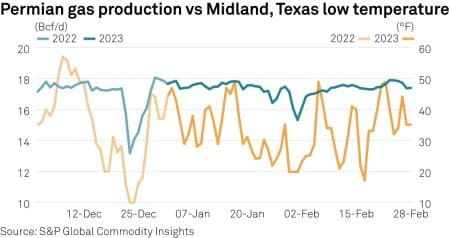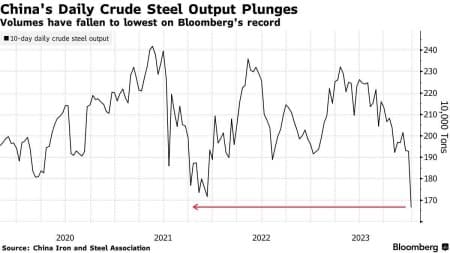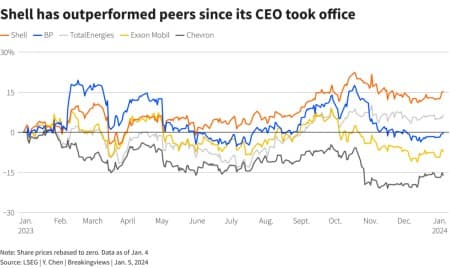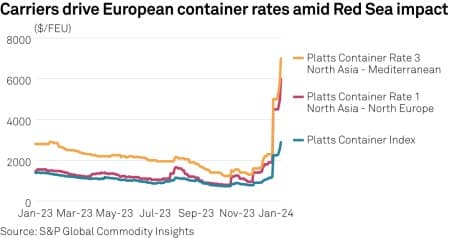1. Biden Revamp of Permitting Rules Scares US LNG Players

- The White House is developing a new set of policy recommendations for new LNG facilities that could significantly slow down the construction of future and pending projects, just as the United States has become the world’s largest LNG exporter.
- The US Department of Energy, the government body issuing LNG export permits to producers, is re-evaluating its project requirements to include the climate impact of proposed liquefaction plants.
- According to the American Petroleum Institute, the review of LNG export applications stretched to more than 330 days under the Biden administration, up from 49 days under President Trump and 155 days under President Obama.
- Environmentalists such as Bill McKibben have specifically singled out Venture Global’s Calcasieu Pass 2 project that is still awaiting approval from the Federal Energy Regulatory Commission.
2. Arctic Freeze to Curb Permian Gas Production

- Oil and gas producers in West Texas are bracing for the coldest weather yet this winter as an Arctic airmass from central Canada is expected to bring sub-freezing temperatures to the Permian Basin, threatening production freeze-offs.
- Historically for Permian gas producers sub-freezing temperatures, especially in single digits, have regularly led to gas output declines, either from voluntary shut-ins or from wellhead freeze-offs.
- Depending on the duration of the cold snap gas production in the Permian could drop by 5-9 BCf per day, inevitably triggering a price rally in Waha spot gas prices that two years ago skyrocketed above $200 per mmBtu.
- Seeing Waha gas prices double over the past week with the balance-of-month gas contract soaring above the $5 per mmBtu mark, it seems that traders are betting on a disruptive cold snap.
3. Chinese Steel Production Suffers as Market Awaits Stimulus News

- Iron ore futures have started 2024 on a bad note, recording five consecutive day-on-day declines earlier this week as weak steel demand continues to weigh on the country’s already high stockpiles.
- Steel production rates in Tangshan, China’s steelmaking hub, have sunk to the lowest level since at least 2019, dropping 14% over the course of December alone as margins remain negative.
- Despite the steel market’s weakness, the benchmark Dalian iron ore futures contract managed to rebound to $136 per metric tonne (¥977/mt) after China’s Central Bank approved a $14 billion loan program to stimulate the real estate market.
- Beijing maintains production caps on steel output to curb unabated air pollution, putting the 2023 annual limit at 1.013 billion tonnes as the steel industry accounts for 15% of China’s emissions.
4. Energy Industry Needs to Limit Massive Methane Releases

- Cutting methane emissions rose to the top of the COP28 climate conference’s agenda, with 50 countries signing up for the Oil & Gas Decarbonization Charter to reach near-zero methane emissions by 2030.
- Conventional onshore fields account for approximately 80% of global methane emissions, Rystad Energy argues, whilst deepwater projects have the lowest methane intensity of all upstream projects thanks to low flaring and better subsurface conditions.
- Russia and the United States dominate the list of top methane emitters globally, although both represent the scattered type of emissions with very few large venting events and a lot of smaller dispersed releases.
- According to the IEA, Turkmenistan, and Venezuela have the highest methane intensity of oil and gas production, around 1.36 kg methane per GJ produced, approximately fourfold the methane intensity of Russia and the US.
5. Asian LNG Prices Defy Seasonality, Fall Below $10 per mmBtu

- Usual pricing seasonality saw Asian LNG prices peak in the winter period, but this year’s winter months have witnessed a continuous decline in LNG quotes as current spot rates dropped below the $10 per mmBtu mark.
- Despite recurrent streaks of frigid weather, temperatures have been above seasonal norms in the wider Asia Pacific region so far, with Japan and South Korea reporting LNG inventories that are respectively 24% and 27% above their 5-year average norms.
- According to Kpler, Asia’s LNG imports have reached a record high of 26.61 million tonnes in December, mostly coming from higher Chinese buying, however ample supply from the US and Australia has limited a price recovery.
- Prices are unlikely to decrease any further as some buyers have started to ramp up purchases amidst sub-$10/mmBtu prices, with India and Thailand announcing ad hoc import tenders for February.
6. When Will Shell Start to Buy Up Shale Producers?

- This week has seen another notable M&A deal after Chesapeake bought Southwestern for $7.4 billion, making it all the more evident that there is one oil major missing out on large acquisitions, Shell.
- Shell remains the second largest publicly traded company worldwide (after ExxonMobil) and has overperformed its peers in 2023, greatly aided by the volte-face of its CEO Wael Sawan on fossil fuel investments.
- Marker rumors are indicating that Endeavor Energy Resources, a $30 billion Permian shale producer, could be Shell’s ideal target as the privately held company boasts the highest operating margin of 81% amongst its US peers.
- Shell might be the best-suited European major to follow in the footsteps of ExxonMobil and Chevron, boasting net debt readings that are just 0.6 times its assumed 2024 EBITDA.
7. Container Freight Boom Raises Risks of Higher Inflation

- 2024 was believed to be the annus horribilis for container companies, but Red Sea attacks have lifted container freight rates to 15-month highs as longer voyage times lead to restricted tanker supply.
- Shipping routes around Africa have increased transit times for container cargoes from Asia to North Europe by 30%, whilst shipments from Asia to the Mediterranean are 60% longer than previously.
- Any container route to Europe now costs above $6000 per FEU, the highest since September 2022, amidst robust bookings as buyers seek to get their tankers ready before the Chinese New Year triggers a slowdown in Asia.
- As container freight rates soared by almost 600% over the past three months, leading US banks such as JPMorgan have been warning of knock-on effects for US inflation, forcing the US Federal Reserve to postpone its first interest rate cut into late 2024.


















